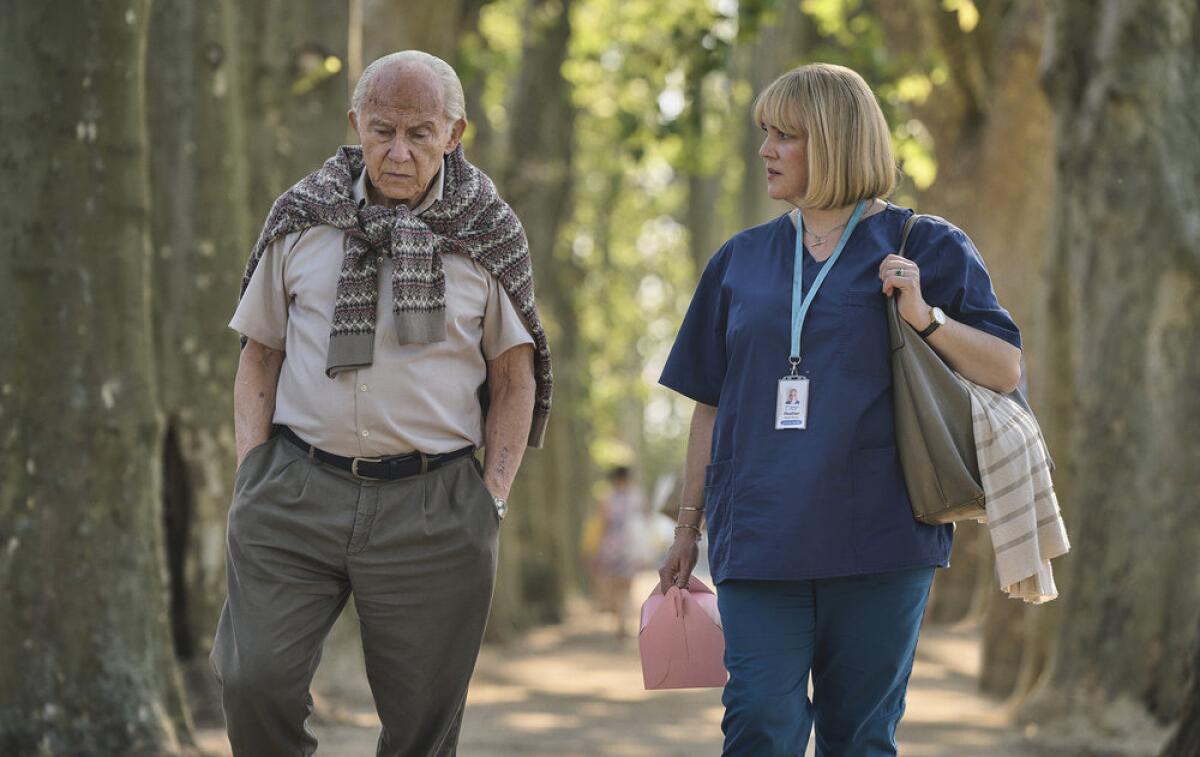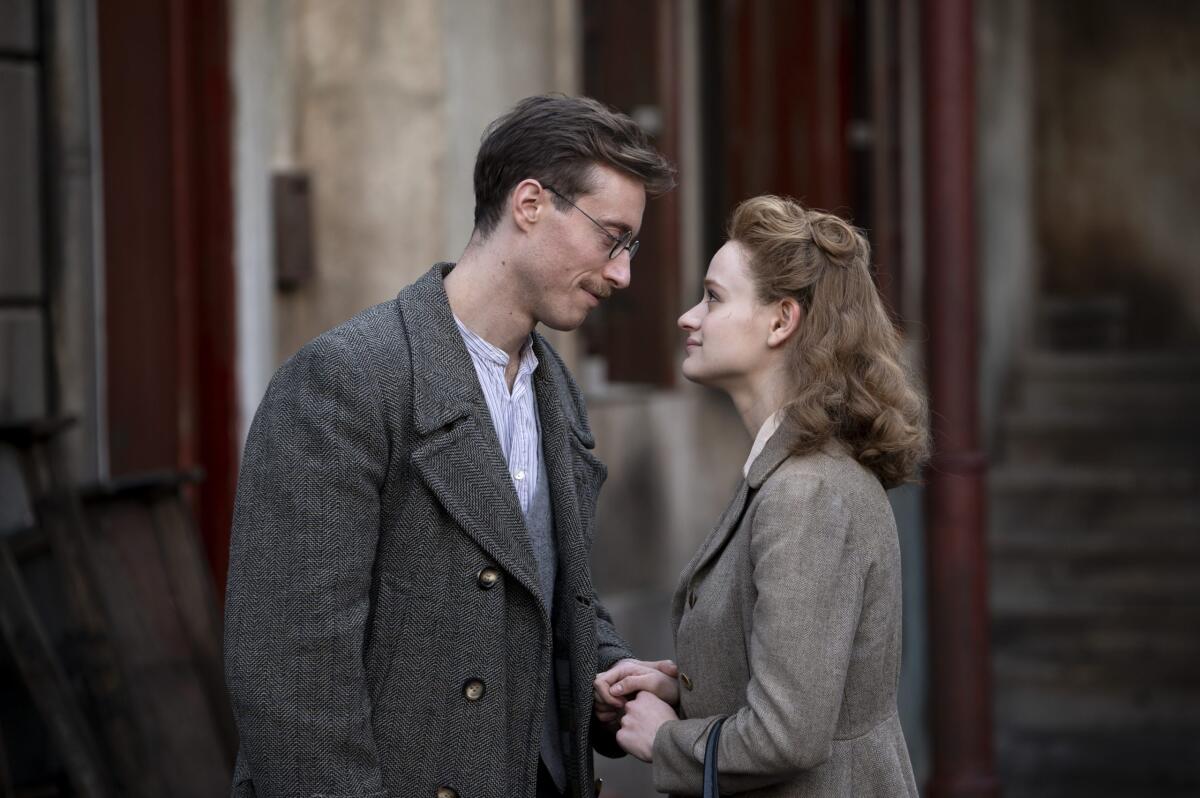It’s been nearly 80 years since the parades, bonfires, Champagne toasts and sailors kissing random strangers in the streets signaled the end of World War II.
But on television? The war still rages.
Recently released miniseries like Apple TV+’s “Masters of the Air” and “The New Look,” Hulu’s “We Were the Lucky Ones,” Netflix’s “All the Light We Cannot See” and Peacock’s “The Tattooist of Auschwitz” all allow audiences to see different voices and stories about the war and the Holocaust.
And we’ll see more of them in the coming weeks. In June, to commemorate the 80th anniversary of the Battle of Normandy, commonly known as D-day, National Geographic will run the limited series “Erased: WWII’s Heroes of Color,” executive produced and narrated by Idris Elba, and the special “The Real Red Tails,” narrated by “Abbott Elementary’s” Sheryl Lee Ralph.
Although the successive release of these series is mostly coincidence, they have arrived at a significant moment when antisemitism has been on the rise and a new war — between Israel and Hamas — has roiled tensions. Protests at universities over the war have spread across the country in recent weeks, and in Hollywood, the war has continued to be a fracture point among artists and those who work in the industry. One of the more public examples was the visceral response to Jonathan Glazer’s Oscar acceptance speech for “The Zone of Interest,” in which the director spoke about the dehumanization of victims of the Holocaust and the Israel- Hamas war.
But for the creators of these series, depicting World War II and its aftermath now is one part of a larger story they want to portray, as is the case with Todd A. Kessler’s “The New Look,” which centers on fashion designer Christian Dior.
“The New Look,” starring Ben Mendelsohn as French fashion designer Christian Dior, is set in Paris at the end of World War II.
(Apple TV+)
“The backdrop of the Nazi occupation of Paris and World War II for this story is essential because in many ways out of this darkest period of 20th century history — if not world history — emerged creativity and a coping mechanism and a way to bring the world back,” says Kessler, who in addition to creating “The New Look” wrote and directed several episodes.
The series is ostensibly a biography of legendary fashion designers like Dior and Coco Chanel (portrayed by Ben Mendelsohn and Juliette Binoche, respectively). But it is also integral in remembering French Resistance fighters like Dior’s younger sister Catherine (portrayed by Maisie Williams). Catherine Dior was apprehended by the Gestapo in July 1944. She was tortured and sent to the Ravensbrück concentration camp in northern Germany on what was dubbed “the last train out of Paris” because the city was liberated two weeks later. She wouldn’t find her way back to Paris until May 1945.
All of this happens only partway through the 10-episode season, which finished its run in April.
“Oftentimes, World War II stories end when Paris is liberated or a camp is liberated or [Holocaust victim] Anne Frank is killed,” Kessler says. “What this story is doing is it’s starting you in the occupation. But then, once the circus of liberation leaves town, it’s how do they pick up the pieces?”
While expanding the scope of World War II historical dramas is one goal, there’s also pressure not to tell these stories in such a way that they become a trope.
“The Tattooist of Auschwitz,” which premiered May 2, is an adaptation of Heather Morris’ bestselling book of the same name. Technically a historical novel, it’s based on the life (and love) that survivor Lale Sokolov experienced in the death camp (In the televised version, Melanie Lynskey plays Morris and Harvey Keitel and Jonah Hauer-King play the older and younger versions of Sokolov, respectively).

“The Tattooist of Auschwitz” is centered on Lale Sokolov (Harvey Keitel), a Holocaust survivor who recounts his story to the writer Heather Morris (Melanie Lynskey).
(Martin Mlaka / Sky UK)
“The narrative storytelling approach literally takes us into his experience of recalling these memories,” says executive producer Claire Mundell, who was instrumental in shepherding “Tattooist” through production. “When he’s with Heather, initially, and he’s beginning to share memories, they are memories that he can face; the ones he’s prepared to share.”
However, she says, when we see Sokolov alone, “and he is replaying these memories … through the drama, we can demonstrate the way in which the trauma has played on his mind, on his consciousness and his levels of guilt.”
Although there is torture and brutality, the story also frequently opts for softer, wordless images of actors playing the nameless people who did not survive. They stare at the camera as if they are staring at the narrator.
“Every scene that we did, I always tried to imagine what Lale might want to see,” says director Tali Shalom Ezer. “The texture; what exactly did he experience? The smell of it; the sounds that were around him. And it always came back to these faces looking at him … and different kinds of looks. Sometimes they were accusing him for being the only one to survive, or sometimes they even looked at him with some compassion.”
Sometimes simply choosing where to put emphasis on the words of a title can add meaning and weight to a project, as showrunner Erica Lipez and others learned while adapting “We Were the Lucky Ones,” author Georgia Hunter’s story of her ancestors: an extensive Polish Jewish family flung around the world leading up to and during the war.
“It so captured the experience of the Jewish diaspora within this one family,” Lipez says of the miniseries, which finished its run May 2. “This is what survival meant for Jews during this period of time.”

Hulu’s “We Were the Lucky Ones,” an adaptation of Georgia Hunter’s book about her Polish Jewish family, stars Sam Woolf and Joey King.
(Vlad Cioplea / Hulu)
Lipez says that as a Jewish person who sought out stories about this chapter in history growing up, she remembers how rarely she saw the Jewish voice centered.
“Jews were perceived as victims of this time but rarely got to be the heroes of their own story or, at the very least, speak for themselves,” she says. Upon discovering the book, she said she “was just floored at what it felt like to see essentially 12 Jewish voices speak for themselves in this series and tell their own story.”
“Lucky Ones” executive producer Thomas Kail, a Broadway veteran who also directed episodes of the Hulu series, says there’s a distinction between new TV shows that take on these matters and revisiting stage productions about them, such as the current Broadway revival of the musical “Cabaret,” which is set in Berlin during the rise of the Nazis and casts Eddie Redmayne as a doomed master of ceremonies.
“The beauty of the theater is that … it’s about interpretation … especially with revivals,” he says.
He continues that adding new projects, like “Lucky Ones,” to the compendium of Holocaust-related materials keeps the conversation going so people don’t necessarily come into a production like “Cabaret” without “that keyhole to peer through.”
“That our show can be a dot on this line of continuum is really meaningful,” Kail says
This is not the first time that the events of World War II have been fodder for TV miniseries. Jason Lynch, a curator at New York’s Paley Center for Media, cited 1978’s “Holocaust,” which he says exposed Germans to the scale of the Holocaust for the first time; 1978’s “Pearl,” about the events leading up to the Pearl Harbor attack; and the 1983 adaptation of Herman Wouk’s “The Winds of War.” More recent examples include the Emmy-winning “Band of Brothers” and “The Pacific,” companion series to “Masters of the Air.”
“World War II has fascinated Hollywood for several decades now, and I feel like the topic lends itself particularly well to the miniseries format,” Lynch says, adding that it allows you to do a deeper dive.
He says World War II was one of the first conflicts with extensive video footage that shows what it was like, and audiences have connections with people who fought in it. Perhaps most important, from a U.S. perspective, this was the last war that was largely supported by the public, he says. The Vietnam War, the backdrop for HBO’s “The Sympathizer,” and the Korean War, which lives on through the film and comedy series “MASH,” were more divisive.
Lynch also points to this year’s Oscar-winning film “Oppenheimer,” which detailed the “what hath I wrought” inner turmoil felt by the father of the atomic bomb. He says that, like any major historical event, it takes time to contextualize its importance and what it means.
“If you’re doing something more reactionary, your take on it is going to be a little different than when you’re viewing it through a longer historical lens,” Lynch says.


